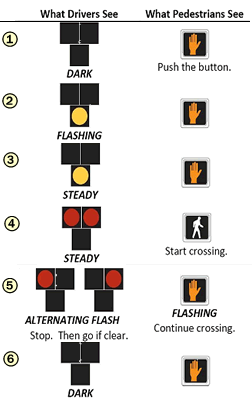Pedestrian Crossing Hybrid Beacons#
You’re stopped at a red light. A pedestrian crosses the street in record time, yet until the crossing signal completes its timed cycle, you’re idling. Imagine a new beacon, which allows you to proceed with caution, once the crosswalk is clear. Introducing pedestrian crossing hybrid beacons! We believe these new beacons (in select intersections) will promote walking, shorten delays, make drivers happier, save fuel and lessen air pollution.
Check out our first pedestrian hybrid beacon, installed at Harmony Road and Regency Drive. Additional beacons are anticipated throughout the Fort Collins.
How The Beacons Work#

- When not activated, the beacon is dark.
- When a pedestrian pushes the walk button, the beacon activates and begins flashing yellow to indicate to drivers someone will be using the crosswalk.
- The beacon then goes to solid yellow like a typical traffic signal, advising drivers to prepare to stop.
- The beacon then turns solid red, requiring drivers to stop at the crosswalk. Pedestrains may cross safely now.
- After a time, the beacon goes to alternating flashing red. Drivers must come to a complete stop, and once the pedestrian has crossed safely, drivers can proceed.
- The beacon returns to dark and awaits the next pedestrian to push the button.
A Little Beacon History#
Researchers around the country are continually developing alternatives to the traditional traffic signal to help pedestrians safely cross major streets. One recent success is a unique beacon system called a pedestrian crossing hybrid beacon. These beacons provide protection to pedestrians by displaying a red light to motorists. However, after a short red interval, the signal changes to flashing red allowing motorists to proceed (after stopping) once the crosswalk is clear, thereby reducing delay for motorists.
According to Tucson Arizona (where these beacons originated) pedestrian crossing hybrid beacons are a success. The technology is so successful the Federal Highway Administration (FHWA) visited Tucson and gave their approval for use in other cities, including Portland, Oregon.